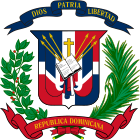| Constitution of the Dominican Republic | |
|---|---|
| Author(s) | Congress of the Dominican Republic |
 |
|---|
|
|
The Dominican Republic has gone through 39 constitutions, more than any other country, since its independence in 1844.[1][2] This statistic is a somewhat deceiving indicator of political stability, however, because of the Dominican practice of promulgating a new constitution whenever an amendment is ratified. Although technically different from each other in some particular provisions, most new constitutions contained only minor modifications of those previously in effect. Sweeping constitutional innovations were relatively rare.[3]
A large number of constitutions do, however, reflect a fundamental lack of consensus on the rules that should govern the national political life. Most Dominican governments felt compelled upon taking office to write new constitutions that changed the rules to fit their own wishes. Not only did successive governments often strenuously disagree with their predecessors' policies and programs, but they often wholly rejected the institutional framework within which their predecessors had operated. Constitutionalism—loyalty to a stable set of governing principles and laws rather than to the person who promulgates them—became a matter of overriding importance in the Dominican Republic only after the death of Rafael Trujillo.[3]
Dominicans historically had agreed that government should be representative and vaguely democratic, that there should be civil and political rights, separation of powers, and checks and balances. Beyond that, however, consensus broke down. The country had been alternately dominated throughout its history by two constitutional traditions, one relatively democratic and the other authoritarian. Rarely were there attempts to bridge the gap between these diametric opposites.[3]
The current Constitution was promulgated on June 13, 2015.[4]
- ^ Cordeiro, Jose Luis (September 29, 2008). "Constitutions around the world : A View from Latin America". Ide Discussion Papers. Retrieved November 6, 2016.
- ^ "Dominican Republic: Government >> globalEDGE: Your source for Global Business Knowledge". globaledge.msu.edu. Retrieved September 27, 2017.
- ^ a b c
 This article incorporates text from this source, which is in the public domain. Jonathan Hartlyn (December 1989). "Constitutional Development". In Haggerty, Richard A. (ed.). Dominican Republic: A country study. Federal Research Division, Library of Congress. LCCN 2001023524.
This article incorporates text from this source, which is in the public domain. Jonathan Hartlyn (December 1989). "Constitutional Development". In Haggerty, Richard A. (ed.). Dominican Republic: A country study. Federal Research Division, Library of Congress. LCCN 2001023524.
- ^ Republic, Dominican (December 21, 2013). Constitution of the Dominican Republic. Gaceta Judicial.